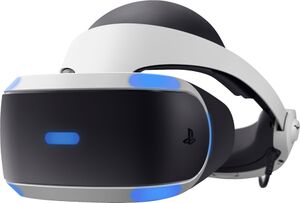Virtual reality: Difference between revisions
(Created page with "{{Infobox_Peripheral | peripheral_name = Virtual reality| peripheral_image = 300px| developer = numerous, see below| publisher = numerous, see below| systems = numerous, see below| release = 1970-present| added_to_museum = '''PlayStation VR'''<br />February 6, 2017<br />'''View-Master (Google Cardboard)'''<br />September 29, 2017<br />'''Google Daydream'''...") |
(add category) |
||
| Line 52: | Line 52: | ||
On April 12, 2019, [[Nintendo]] released the [[Nintendo Labo|Labo VR Kit]], designed by [[Nintendo European Research & Development]], which was a do-it-yourself cardboard VR headset for the [[Nintendo Switch]]. | On April 12, 2019, [[Nintendo]] released the [[Nintendo Labo|Labo VR Kit]], designed by [[Nintendo European Research & Development]], which was a do-it-yourself cardboard VR headset for the [[Nintendo Switch]]. | ||
[[Category:Computer and | [[Category:Computer and video game peripherals]] | ||
[[Category:Computer and video game peripherals released in 1970]] | |||
[[Category:Virtual reality]] | [[Category:Virtual reality]] | ||
Latest revision as of 15:07, 14 December 2023

| |
| Virtual reality | |
| Developer | numerous, see below |
|---|---|
| Publisher | numerous, see below |
| Systems | numerous, see below |
| Released | 1970-present |
| Added to Museum | PlayStation VR February 6, 2017 View-Master (Google Cardboard) September 29, 2017 Google Daydream September 12, 2018 |
Virtual reality is the name for an experience that allows the user to interact with computer graphics, simulating reality or a world unlike the real-world. Virtual reality is usually presented through a head-mounted display.
Early history
By 1970, the computer industry had begun drifting away from the vacuum tube technology of the earliest computers to transistors. This made computers more affordable, so applications for computers were envisioned that were vastly different from the prior uses of computer technology.
In 1970, Ivan Sutherland and Bob Sproull developed the first head-mounted computer display. When combined with input mechanisms such as light pens or joysticks, head-mounted displays could be used for a variety of purposes in training situations or in environments where precise control was necessary. As a result, from 1970 to 1990, these devices were primarily used for medical, flight simulation, automobile industry design, and military training purposes.
In the 1980s, the term virtual reality was popularized for these head-mounted devices by a computer scientist named Jaron Lanier.
Stereo-scopic 3D head-mounted displays
By the 1980s, head-mounted displays that output stereoscopic 3D images began to be designed for video gaming.
In August 1987, Sega released the SegaScope 3-D Glasses for the Sega Master System.
On October 21, 1987, Nintendo released the Famicom 3D System for the Family Computer in Japan.
In 1996, Nintendo's Virtual Boy video game console was released. It output stereoscopic red-on-black graphics through a headset display, although it sat on a stand rather than being head-mounted like most devices of its kind.
Early head-tracking virtual reality headsets
In the 1990s, head-tracking virtual reality headsets began to be released.
In 1991, Sega announced the Sega VR headset. It was originally announced to be for arcades as well as for the Sega Genesis/Mega Drive video game console. It was never released, however, on November 20, 2020, the Video Game History Museum, in conjunction with Gaming Alexandria, released a compiled version of Nuclear Rush. This game was developed in 1993 and was intended for use on the Sega Genesis with a Sega VR headset. They also released an emulator to play the game.
In 1994, an unrelated project titled the Sega VR-1 motion simulator was installed as an amusement arcade attraction in Joypolis and Sega World locations. This on-rails ride was available at Sega theme parks and Sega World locations until 1997.
Virtual reality becomes popular in the 2010s
By the 2010s, computer hardware had become advanced enough that many of the technical limitations of early virtual reality applications could be overcome.
Because of this, many manufacturers introduced virtual reality hardware during this decade.
In 2010, the first prototype of the Oculus Rift VR headset was developed. The first commercial Oculus Rift device was released, on March 29, 2013, to backers of a 2012 Kickstarter crowdfunding campaign. Facebook purchased Occulus VR for $3 billion USD in 2014.
In 2013, Valve freely shared its discovery of low-persistence displays which made lag-free and smear-free display of VR content possible. This was then added to the Oculus Rift.
In 2014, Valve showcased the SteamSight prototype. Valve partnered with HTC, and premiered the HTC Vive VR headset in 2015. This headset included LED light tracking technology that was performed by multiple wall-mounted sensors. The first commercial HTC Vive device was released on April 5, 2016.
Also in 2014, Sony announced the prototype VR headset for the PlayStation 4 that was code-named Project Morpheus. The first commercial version of Sony's VR headset, named PlayStation VR, was released on October 13, 2016.
On June 25, 2014, Google released a simple do-it-yourself VR headset that attached to mobile devices named Google Cardboard. As the name suggests, the device can be constructed using only cardboard. Several professionally-produced plastic VR devices were released that were compatible with the Google Cardboard standard, including a device by Mattel that invoked the design and name of their popular View-Master devices.
On November 10, 2016, Google released the Google Daydream VR standard. Daydream was built into Android and included enhanced features that Google Cardboard did not, including support for controllers.
On April 12, 2019, Nintendo released the Labo VR Kit, designed by Nintendo European Research & Development, which was a do-it-yourself cardboard VR headset for the Nintendo Switch.